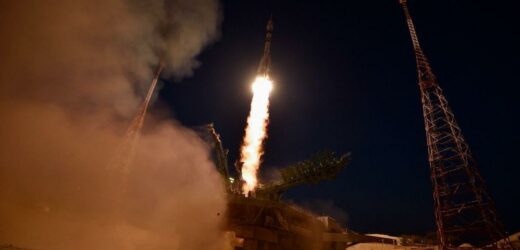Russian air defences attempt to take down missile
We use your sign-up to provide content in ways you’ve consented to and to improve our understanding of you. This may include adverts from us and 3rd parties based on our understanding. You can unsubscribe at any time. More info
Two Russian cosmonauts and a US astronaut have been left stranded on the International Space Station (ISS) after a technical issue with the Soyuz MS-22 spacecraft that was supposed to return them to Earth. Now, Russia will have to launch another Soyuz rocket to return them. Sergei Prokopyev, Dmitry Petelin and Francisco Rubio were set to return to the Blue Planet aboard the Soyuz MS-22 in March following a mission on the ISS.

But last month, their original capsule suffered from a so-called coolant leak, which reportedly came from a tiny puncture in the external radiator of the Soyuz MS-22 capsule currently docked on the ISS.
Russian space agency Roskosmos said: “The expedition of Sergey Prokopyev, Dmitry Petelin and Francisco Rubio to the ISS is being extended. They will return to Earth on Soyuz MS-23.
“The launch of the Soyuz MS-23 will be on Feb. 20, 2023 in an unmanned mode.”
The damage to the radiator pipeline reportedly came as a result of a meteorite, according to the space agency. Roscosmos added that the “diameter of the hole is less than 1 millimeter”.
The incident has caused major disruption for Russia’s ISS plans, slamming the breaks on planned spacewalks by its cosmonauts as officials prioritise fixing the leaky capsule, which was a lifeboat for the crew.
However, this is also likely to cause headache for NASA, which said last month that it was assessing whether SpaceX’s Crew Dragon spacecraft provide a ride home for some ISS crew members as an alternative if Russia fails to launch another Soyuz rocket.
The Soyuz programme is the longest operational human spacecraft programme the history of space exploration, with the first-ever crewed flight into space taking place back in April 23 1967.
The spacecraft generally weigh 7 tonne and measure 7.2 metres in length and 2.7 metres in diametre. They open solar panels open after the launch and can carry up to three astronauts at a time, according to the European Space Agency’s website.
This is a breaking story. More to follow.
For the latest news and breaking news visit: /news
Stay up to date with all the big headlines, pictures, analysis, opinion and video on the stories that matter to you.
Follow our social media accounts here on facebook.com/DailyExpress and @Daily_Express
Source: Read Full Article


